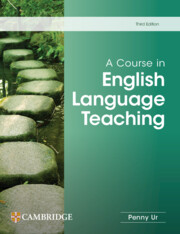Book contents
- Frontmatter
- Contents
- Acknowledgements
- Introduction
- 1 Teaching English today
- 2 The lesson
- 3 Classroom interaction
- 4 Tasks
- 5 Texts
- 6 Teaching vocabulary
- 7 Teaching grammar
- 8 Teaching listening
- 9 Teaching speaking
- 10 Teaching reading
- 11 Teaching writing
- 12 Feedback and error correction
- 13 Assessment and testing
- 14 The syllabus
- 15 Teaching/learning materials
- 16 Teaching content
- 17 Classroom discipline
- 18 Digital technology and online teaching
- 19 Learner differences 1: age
- 20 Learner differences 2: diversity and inclusion
- 21 Teacher development
- Glossary
- References
- Index
18 - Digital technology and online teaching
Published online by Cambridge University Press: 15 March 2024
- Frontmatter
- Contents
- Acknowledgements
- Introduction
- 1 Teaching English today
- 2 The lesson
- 3 Classroom interaction
- 4 Tasks
- 5 Texts
- 6 Teaching vocabulary
- 7 Teaching grammar
- 8 Teaching listening
- 9 Teaching speaking
- 10 Teaching reading
- 11 Teaching writing
- 12 Feedback and error correction
- 13 Assessment and testing
- 14 The syllabus
- 15 Teaching/learning materials
- 16 Teaching content
- 17 Classroom discipline
- 18 Digital technology and online teaching
- 19 Learner differences 1: age
- 20 Learner differences 2: diversity and inclusion
- 21 Teacher development
- Glossary
- References
- Index
Summary
Preliminary note. The particular websites and apps mentioned in this chapter may have been renamed or even have disappeared by the time you read this; you may need to find updated ones through a search engine.
Digital literacies
In order to make best use of the learning opportunities that online digital technology offers, students need to possess not just one but a number of digital literacies. In this section, I’ll summarise those that seem to me most important for language learners: for a longer and more detailed list, see the first chapter of Pegrum et al. (2022).
Print literacy
At its most basic level, print literacy is the same literacy as that needed to read books and other kinds of paper-based publications. Research indicates that most students still prefer reading longer texts from paper rather than from a screen (Baron, 2017), and that their comprehension tends to be better when based on reading from a print version (Mangen et al., 2013). My impression is that this applies to the wider population as well. (I myself prefer reading from a screen, but am aware that I am in the minority!) In any case, everyone today needs to know how to cope with online reading, including ease of reading different design formats (infographics, for example) and the use of hyperlinks to move between different texts.
Print production literacy is the ability to use a keyboard fl uently and accurately to produce written English text. Most students develop this skill gradually as they get used to using a keyboard as well as pen and paper for their writing, but it can be improved by learning to touch-type using one of the many available online courses.
Editing literacy means using online tools appropriately for editing; not just the wordprocessing tools of emboldening, italicizing, enlarging, contracting, deleting, cutting-andpasting, inserting and moving text, but also the more sophisticated annotating tools such as inserting margin- or footnotes, or using editing tools such as track changes in Microsoft Word.
Hyperlink literacy involves knowing when it is worth clicking on a hyperlink in order to follow it up, and how to return to the main text later, as well as how to insert your own hyperlinks.
Information
- Type
- Chapter
- Information
- A Course in English Language Teaching , pp. 245 - 261Publisher: Cambridge University PressPrint publication year: 2024
